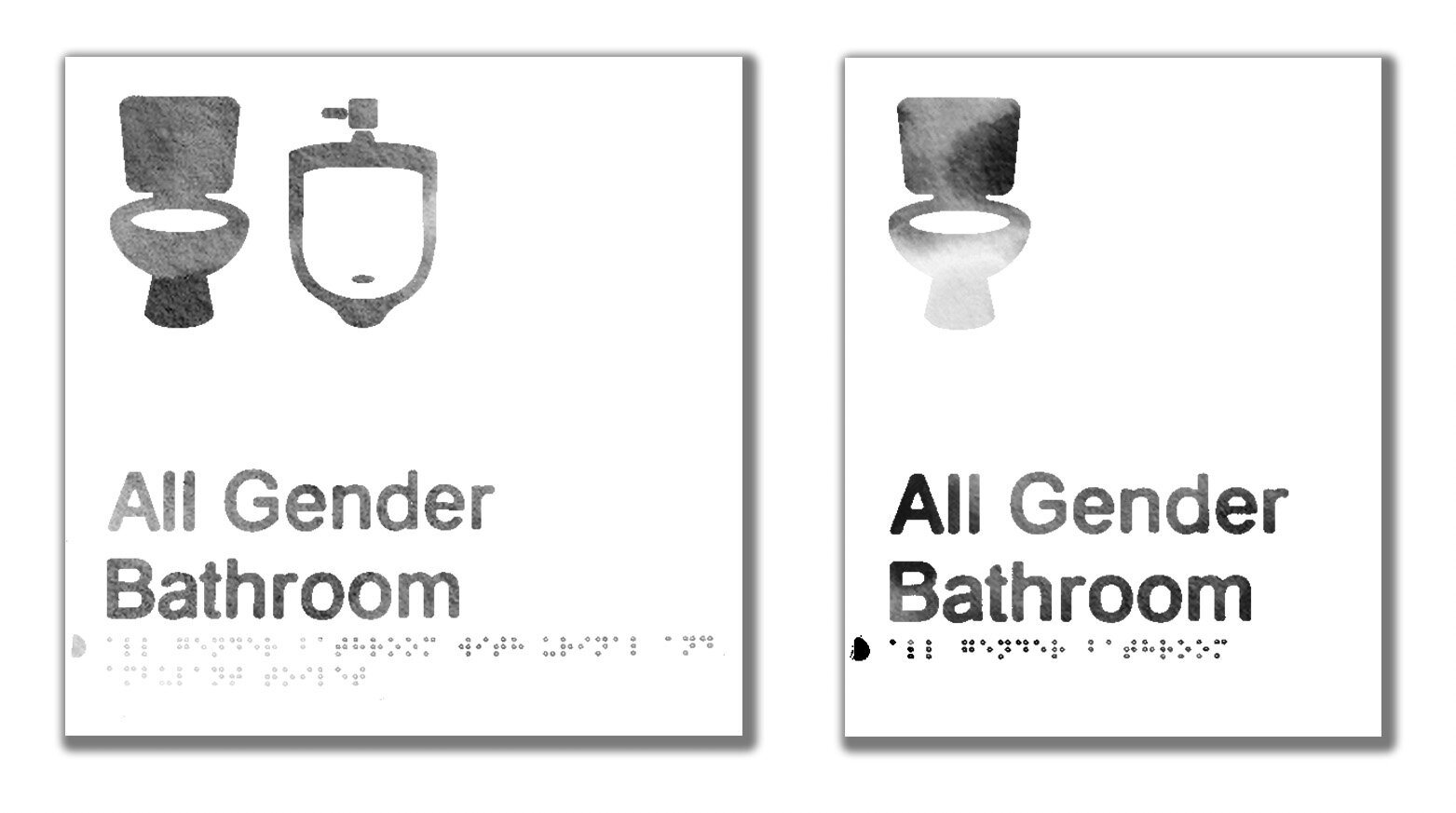Bathrooms
On this page:
Laws & legislation All-gender bathrooms Signage Bathroom myths
Bathroom access can be a big deal to trans people simply because everyone has to pee. Providing facilities for every person in your organisation, institution, or space is a legal requirement for all buildings, and thinking about how these facilities might affect or affirm trans and gender diverse people is important. This includes trans people who are male or female, as well as non-binary people.
Everyone, everywhere has the right to access safe and appropriate toilets.
Water Aid
Laws & legislation
Trans people are protected against discrimination, harassment and violence in many areas under NSW and federal law. Laws also protect your safety in public, and your privacy when interacting with large organisations or government departments. Find out more at Rights and Justice.
To restrict any person from using the bathroom that best affirms their gender may be unlawful. This includes trans people who have not legally affirmed their gender, or engaged in any surgical intervention.
The National Construction Code (NCC), and in particular the Building Code of Australia (BCA) Volume One Part F21 dictates how many bathrooms are to be constructed according to the class or type of building constructed, and how many washbasins, ‘closet pans’ (toilets), and urinals they are to contain. This is largely dependent on how many people are using bathrooms, their location, and their function (e.g. for a fixed number of staff, or for the public).
The current BCA does not provide for multi-stall all-gender bathrooms for most building classes unless a premises is used predominantly by people of one gender, if there are no more than 10 people employed or based on the specific use of a building, such as a patient ward of a healthcare building. The minimum number of gendered bathrooms is outlined in Table F2.3 of the BCA.
It is worthwhile counting how many gendered stalls, urinals and wash basins you currently have and cross-reference this with the number of female and male bathroom users you have. You might realise you can designate an entire set of bathrooms to be all-gender.
All-gender bathrooms
Organisations can engage a building certifier in order to implement all-gender toilets rather than gendered facilities, and still meet the necessary legal requirements.
“The NCC (BCA) specifies the number of male/female pans and basins based on the population of the building. A performance solution from a building certifier can address this requirement where gender neutral toilets are provided in lieu of the traditional gender split.”
GPT Gender Neutral Bathrooms Considerations
When thinking about bathrooms, it’s important to not think of them as ‘transgender toilets’, but rather as bathrooms that everyone will use, regardless of gender. If you label bathrooms as having either toilets or toilets and urinals, people of all genders will be able to make a decision about the bathroom they’d prefer to use at any given moment. All-gender bathrooms are not new - most of us have one in our home.
Sanitary bins
It’s a good idea to have sanitary bins in all cubicles, but if that is not possible, consider labelling which cubicles have these facilities.
Signage
All signs that relate to access and mobility should comply with Australian Standard 1428.11.
A great option is to label what facilities are available behind the bathroom door, such as whether the bathroom contains toilets, urinals, or change tables, like the graphics below.
Signs that include additional unnecessary information, illustrations, or jokes aren’t helpful or trans affirming. Featuring non-human characters e.g. aliens, centaurs, etc. or statements like “It doesn’t matter, just wash your hands” in lieu of describing what is in the bathroom may not meet the Australian Standard.
By clicking on the below images you can download PDF versions you can print for events or groups, or buy tactile versions at a store such as Pictobraille.
Bathroom myths
“A person is only legally allowed to access the bathroom that aligns with the gender marker on their birth certificate / ID / body parts”
The NSW Anti-Discrimination Act (1977) states that it is unlawful to discriminate against someone due to their transgender status or perceived transgender status (that is, if they’re not trans but are assumed to be by someone else), including when it comes to accessing bathrooms.
“Unisex Accessible toilets are sufficient”
Trans people who are not disabled don’t want to occupy bathrooms designated for people with accessibility needs.
Trans people may receive unwanted attention, with others questioning why they are using a bathroom for mobility impaired people.
The word “Unisex” assumes a binary male or female. Consider using terms like “all gender” instead.
All-gender bathrooms can reduce waiting times for all people.
“We don’t need to provide gender neutral facilities because we have no trans or gender diverse staff / students / clients”
It’s likely that there are already trans people around you, and already using bathrooms. You might not be aware of them though, particularly if they don’t feel supported and safe to come out.
Implementing all-gender facilities shows trans people that your organisation is potentially a safe place for them.
Links
1 The National Construction Code
All gender braille signs - Pictobraille
Toilets for everyone – moving to gender neutral bathrooms in our London office - WaterAid
Why we need gender-neutral bathrooms - Ivan Coyote for TEDx





